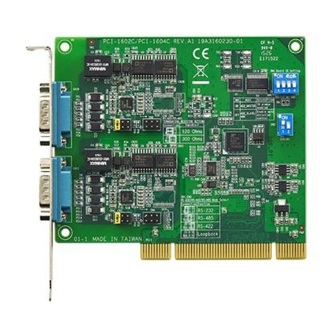
Advertisement
Quick Links
This documentation and the software included with this product are
copyrighted 2001 by Advantech Co., Ltd. All rights are reserved.
Advantech Co., Ltd. reserves the right to make improvements to the
products described in this manual at any time without notice.
No part of this manual or software may be reproduced, copied,
translated or transmitted, in any form or by any means without the
prior written permission of Advantech Co., Ltd. Information provided
in this manual is intended to be accurate and reliable. However,
Advantech Co., Ltd. assumes no responsibility for its use, nor for any
infringements of rights of third parties which may result from its use.
PC-LabCard is a trademark of Advantech Co., Ltd. IBM, PC and
PC/XT/AT are trademarks of International Business Machines
Corporation. MS-DOS, MASM, QuickBASIC, Microsoft C and MS-
PASCAL are trademarks of Microsoft Corporation. Intel is a trademark
of Intel Corporation. Turbo C and Turbo PASCAL are trademarks of
Borland International.
2nd Edition
Printed in Taiwan
July 2001
Advertisement

Summarization of Contents
Chapter 1 Introduction
Description
Explains the PCI Local Bus and Advantech's serial communication cards.
Features
Lists the key features of the PCI Comm Card Series.
Specifications
Details technical specifications including bus interface, data signals, and controller.
Power Requirements and Dimensions
Provides power consumption details and physical dimensions for various models.
Ordering Information
Lists available product models, interfaces, and protection options.
Chapter 2 Hardware Configuration
Initial Inspection
Instructions on checking the product package contents and for shipping damage.
Jumper and Switch Locations
Diagrams illustrating the placement of jumpers and switches on the PCI cards.
Card Installation
Step-by-step guide for physically installing the PCI communication card into a computer.
RS-422/485 Selection
How to set the RS-422 or RS-485 mode for each port using jumpers.
Enable Mode Selection
Configuration of the port's enable mode via DIP switches.
Terminator Resistor Setup
Guidance on installing termination resistors for impedance matching.
Chapter 3 Driver Setup & Installation
Overview of Driver Setup
Introduces driver installation procedures for Windows 95/98 and Windows NT.
Windows 95/98 Driver Setup
Detailed steps for installing drivers on Windows 95/98 systems.
Reboot System and Driver Installation (Win 95/98)
Covers system reboot and initial device driver installation for Win 95/98.
PCI Bridge Device Driver Installation
Steps for installing the PCI Bridge device driver after UARTs.
Verify Win95/98 Driver Setup
How to confirm the successful installation of drivers in Windows 95/98.
Configure PCI ICOM Devices (Win 95/98)
Steps to configure serial devices and FIFO properties within Windows 95/98.
Configure PCI UARTs Device
Detailed configuration steps for Advantech PCI UARTs devices.
Configure PCI Bridge Device
Steps to check and configure the PCI Bridge device settings.
Configuring Ports
Procedures for configuring communication port settings in Windows.
Remove PCI ICOM Series Device
Instructions on how to remove the Advantech PCI ICOM series device.
Complete Driver Uninstall (Win 98/98)
Steps for a complete uninstall of Win95/98 drivers using AdsCleaner utility.
Windows NT Driver Setup
Step-by-step guide for installing drivers on Windows NT systems.
Start Device Function (Windows NT)
How to start the Advantech PCI Serial Service in Windows NT.
Verify NT Driver Setup
How to verify the installed COM ports in Control Panel for Windows NT.
Verify NT Driver Function
Using NT Diagnostics utility to check if the PCI serial driver is running.
Stop Device Function (Windows NT)
Instructions to stop the Advantech PCI Serial Service in Windows NT.
Chapter 4 ICOM Tools
Introduction to ICOM Tools
Overview of the Advantech ICOM Tools utility for port status analysis.
ICOM Tools Installation
Steps to install the ICOM Tools utility from the provided diskette or CD-ROM.
ICOM Tools User Interface
Explanation of the Graphical User Interface, menu bar, and toolbar buttons.
Using the ICOM Tools Utility
Guide on launching and accessing the port testing utility.
Port Selection
Procedure for selecting specific ports to test within the ICOM Tools.
Configure the Port
How to configure port settings such as baud rate, data bits, and parity.
Run the Test
Steps to initiate a port test using the ICOM Tools utility.
Stop the Test
Instructions on how to stop a running port test.
Close Port
How to close a selected port within the ICOM Tools application.
Exit ICOM Tools Utility
Procedure for exiting the ICOM Tools application.
Status and Message Log Area
Explanation of the Status Bar and Message Logo area functions and details.
Chapter 5 Pin Assignment & Wiring
Pin Assignments PCI-1601/1602
DB-9 male connector pin assignments for RS-422 and RS-485 modes.
RS-422 Signal Wiring
Wiring details for RS-422 interface, enabling full duplex communication.
Pin Assignments PCI-1610/1612 (RS-232)
Pin assignments for DB-37 and DB-25 connectors for RS-232.
Pin Assignments PCI-1612 (RS-422/485)
Pin assignments for DB-37 connectors for RS-422/485.
Pin Assignments PCI-1610/1612 (RS-232)
Pin assignments for DB-37 and DB-9 connectors for RS-232.
Pin Assignments PCI-1620 (RS-232)
Pin assignments for the DB62 connector on PCI-1620 for RS-232.
RS-232 Signal Wiring
General information on RS-232 signal wiring and DTE/DCE connections.
Modem Connections
Specific wiring configurations for modem (DCE) connections.
Terminal without Handshake
Simplified wiring for terminal connections without handshake signals.
RS-422 Signal Wiring
Wiring details for RS-422 interface, supporting full duplex communication.
Terminator Resistors Setup
Instructions for installing termination resistors for impedance matching.
RS-485 Signal Wiring
Wiring topology and explanation for RS-485 half-duplex communication.
Termination Resistor Setup
Details on installing termination resistors for impedance matching in RS-485.
Appendix A Register Structure and Format
Register Structure
Descriptions of module registers and their bit configurations for UART chips.
Programming Example
A C code example demonstrating direct register programming for UART functions.
Appendix B PC I/O Address Reference
Standard PC I/O Addresses
A table of common I/O addresses used by PC devices to avoid conflicts.
















Need help?
Do you have a question about the PCI-1612 and is the answer not in the manual?
Questions and answers